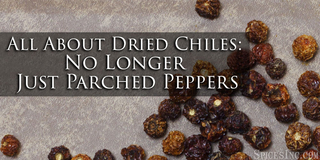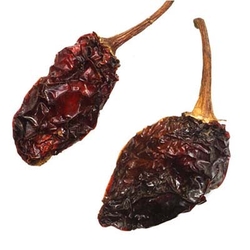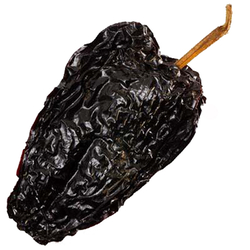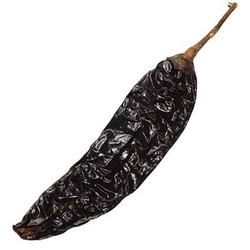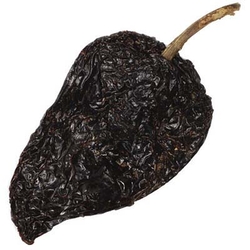How to Rehydrate Dried Chiles and Peppers
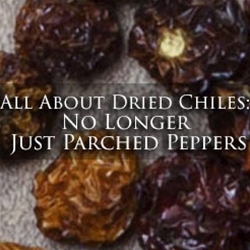
From surface texture alone, dried chiles can be an intimidating ingredient. Usually when shopping for chiles (or peppers) you're looking for plump, juicy, and the least amount of wrinkly-ness possible… but the dried chile defies all those conventions. Dried chiles are ideally dehydrated in the sun and not in an oven, and their color, length, and shape are all affected by the region, level of maturation they're grown to, and method of drying.
Dried chiles are commonly associated with Central and South American cuisine, but dried chiles appear in diets on just about every continent. Their longevity and shelf-stable nature makes them an invaluable ingredient and they have uses in both their dried and rehydrated form.
How Do You Store Dried Chiles?
If you're not ready to rip into your chiles as soon as you get them home, there's a couple things you'll want to know for where to keep them. Store your dried chiles in a cool, dark place that is away from anywhere it might be damp or have any moisture. An airtight storage bag would be great, and if you want to go a step further pack your storage bag into an opaque box that will keep it from the light to prevent it from being discolored on one side from frequent sun exposure.
How Do You Rehydrate Chiles?
When most people think of dried chiles, their first instinct is to make them NOT dried anymore. If you're looking to rehydrate your chiles, we promise it's an easy process:
- Cut the top off of each chile to remove the stem.
- Cut a slit down the side of the chile to split it open.
- The majority of the seeds will shake right out. Use your fingers or a spoon to scrape any additional seeds off and pull off any dried veins.
- Discard the seeds- While most people associate the seeds with being the heat of the chile (the majority of the capsicum is actually in the membrane, and not the seeds), scraping out the seeds is recommended as they often become extremely hard and unpalatable as the moisture is depleted in the chile.
- Place the chiles on a medium/hot griddle and roast them for 3-4 minutes.
- Turn often to prevent burning.
- Remove from griddle and place them in a bowl and cover them with hot water.
- Soak for 20-30 minutes.
Avoid soaking them too long, as the liquid will start to turn bitter the longer it sits and the chile will start to reabsorb the less tasty water. Once your chiles been rehydrated, you can use it to make a salsa, or a condiment paste- Some of our favorite are a Szechuan Hot Sauce or Chile Colorado to save any of your bland or less inspired recipes.
What Can I Do with Dried Chiles?
If you're not interested in rehydrating your chiles you could also use your dried chiles to make your own chile powder. Making Chile (or Chili) Powder is easy and ensures that your powder is pure chile and salt free. Another option for dried chiles is rehydrating them to use in sauces or other dishes when you don't have their fresh counterparts available. Whether you intend to use them in their dry form or their rehydrated form, we recommend dry roasting your spices to warm the oils in them and wake them up after being asleep for so long! Pull them out of your pan or off your stovetop as soon as it starts to smell burnt- you want to walk the line between "charred" and "toasty," avoiding "absolutely inedible blackened garbage."
Should You Wash Dried Chiles?
If you're on the fence about washing dried chiles, we recommend waiting until just before you're going to use them to wash them. To wash your dried chiles, simply rinse them with a little warm water and no soap. If you're going to rehydrate them, you won't need to worry about drying them, but if you plan on turning them into chile powder we recommend letting them air dry for at least 24 hours and then toasting before trying to grind them. If there is any moisture at all in your chiles, your powder could clump or possibly look more like the beginning part of a paste than a chile powder and making it much more difficult to have an even consistency.
What are the Different Names of Dried Chiles? What do they Mean?
You know how dried grapes are called raisins, and dried plums are called prunes? Well the same theory applies for fresh and dried chiles, though they also might somehow indicate an additional process the chile has gone through in addition to being dried, such as ripened to a certain point or smoked. If you have a recipe that calls for a chile you've never seen before in the produce section, it's worth checking to see if it's actually the name of a dried counterpart. Here are some of the most common:
- Ancho chile: dried Poblano chile that are picked while they are red and ripe.
- Mulato chile: dried Poblano chile that are left on the vine well past when they are red, and instead harvested when they are dark brown and already partially dried.
- Pasilla chile: dried Chilaca chile, but can also be used as an umbrella term for describing other skinny, long dried chiles.
- Morita chile: dried, smoked jalapeno when it's still its green color.
- Meco chile: dried, smoked jalapeno when it's allowed to ripen to its red color.
What Does a Dried Chile Taste Like?
Because of how many different types of chile peppers are dried, every flavor for each is unique, and it's a good idea to check out our chile page to see how they rate in terms of heat and flavor before making a guess on a substitution. Because of their loss of moisture, chiles usually contain the most concentrated essence of themselves- sweetness is more pronounced, smokiness is obvious, and you can sometimes actually smell the "heat" associated with the capsicum. Also, another consideration to have when shopping and using dried chiles is comparing how long the chile was allowed to ripen before being harvested and dried, which will result in different tastes (and often size) of your chile.
What Else Can You Do with Dried Chiles?
If you love the idea of an ever-green wreath, why not have an ever-red one too? A chile ristra is a beautiful decorative ornament, but it can also be used as tool for actually storing your dried chiles elegantly. Ristras are commonly associated with the holidays and Christmas time as a matter of convenience: Usually they are created after a chile harvest is done in the Summer using fresh chiles, and then by the end of December the chiles have dried out completely. Though it's not recommended at all, it's not uncommon to be serenaded by the sound of joyful cascabel chile rattles while passing through our production floor on a busy morning.

